

04-intermolecular-forces-01. You will also recall from the previous chapter, that we can describe molecules as being either polar or non-polar.
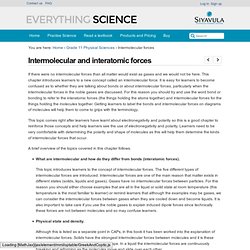
Presentation "AP Chemistry Notes Solutions & Colligative Properties." Chapter 9, Section 3. The shape of a molecule and the polarity of its bonds together determine the charge distribution in the molecule.

A molecule is said to be polar if its centers of negative and positive charge do not coincide. Environmental Chemistry. Print book.
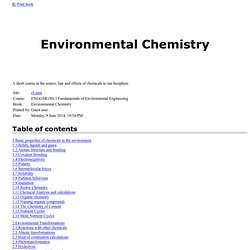
Intermolecular forces. Bonding in Metals and Semiconductors. 1 Properties of metals The fact that the metallic elements are found on the left side of the periodic table offers an important clue to the nature of how they bond together to form solids.
These elements all possess low electronegativities and readily form positive ions Mn+. Because they show no tendency to form negative ions, the kind of bonding present in ionic solids can immediately be ruled out. The metallic elements have empty or nearly-empty outer p-orbitals, so there are never enough outer-shell electrons to place an octet around an atom. These points lead us to the simplest picture of metals, which regards them as a lattice of positive ions immersed in a “sea of electrons” which can freely migrate throughout the solid. Electrical conductivities . Malleability. Bands, Bonds, and Doping. Periodic Trends Experiment For information or comments on this tutorial, please contact R.
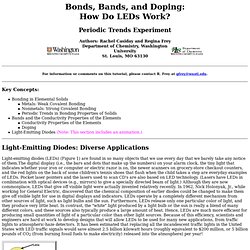
Frey at gfrey@wustl.edu. Key Concepts: 12.6 Bonding in Metals and Semiconductors. Bonding in metals and semiconductors can be described using band theory, in which a set of molecular orbitals is generated that extends throughout the solid.
The primary learning objective of this Module is to describe the electrical properties of solid using band theory. Band Theory To explain the observed properties of metals, a more sophisticated approach is needed than the electron-sea model described in Section 12.5. The molecular orbital theory used to explain the delocalized π bonding in polyatomic ions and molecules such as NO2−, ozone, and 1,3-butadiene can be adapted to accommodate the much higher number of atomic orbitals that interact with one another simultaneously in metals. In a 1 mol sample of a metal, there can be more than 1024 orbital interactions to consider. One-Dimensional Systems If the distance between the metal atoms is short enough for the orbitals to interact, they produce bonding, antibonding, and nonbonding molecular orbitals. Multidimensional Systems Band Gap. Conductors - Insulators - Semiconductors - Fundamentals - Semiconductor Technology from A to Z - Halbleiter.org.
Conductors Conductors are generally substances which have the property to pass different types of energy.
In the following, the conductivity of electricity is the value of interest. Metals: The conductivity of metals is based on the free electrons (so-called Fermi gas) due to the metal bonding. Already with low energy electrons become sufficiently detached from the atoms and a conductivity is achieved. Metallic bonding: fixed ions and free valence electrons (Fermi gas) The conductivity depends, inter alia, on the temperature. Salts: In addition to metals, salts can also conduct electricity. Insulators Insulators possess no free charge carriers and thus are non-conductive. Band Theory for Solids. Metallic Bonding. Metals have several qualities that are unique, such as the ability to conduct electricity, a low ionization energy, and a low electronegativity (so they will give up electrons easily, i.e., they are cations).
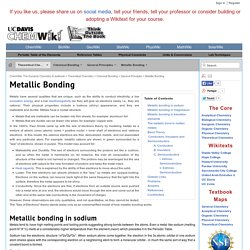
Their physical properties include a lustrous (shiny) appearance, and they are malleable and ductile. Metals have a crystal structure. Metals that are malleable can be beaten into thin sheets, for example: aluminum foil. Metals that are ductile can be drawn into wires, for example: copper wire. Ch12_lecture_6e_final. HPLC Separation Modes : Waters. In general, three primary characteristics of chemical compounds can be used to create HPLC separations.

They are: • Polarity• Electrical Charge• Molecular Size First, let’s consider polarity and the two primary separation modes that exploit this characteristic: normal phase and reversed-phase chromatography. Separations Based on PolarityA molecule’s structure, activity, and physicochemical characteristics are determined by the arrangement of its constituent atoms and the bonds between them.
Within a molecule, a specific arrangement of certain atoms that is responsible for special properties and predictable chemical reactions is called a functional group. Figure P: Chromatographic Polarity Spectrum by Analyte Functional Group Water [a small molecule with a high dipole moment] is a polar compound. Intermolecular Interactions.
Types of molecular units The very existence of condensed states of matter suggests that there are attractive forces acting between the basic molecular units of solids and liquids.
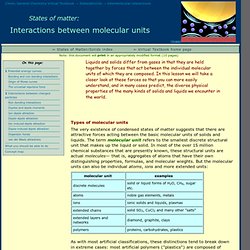
The term molecular unit refers to the smallest discrete structural unit that makes up the liquid or solid. In most of the over 15 million chemical substances that are presently known, these structural units are actual molecules— that is, aggregates of atoms that have their own distinguishing properties, formulas, and molecular wieghts. As with most artificial classifications, these distinctions tend to break down in extreme cases: most artificial polymers ("plastics") are composed of molecules of various sizes and shapes, some metal alloys contain identifiable molecular units, and it is not too much of a stretch to regard a diamond or a crystal of NaCl as a "molecule" in itself. 1 Potential energy curves.